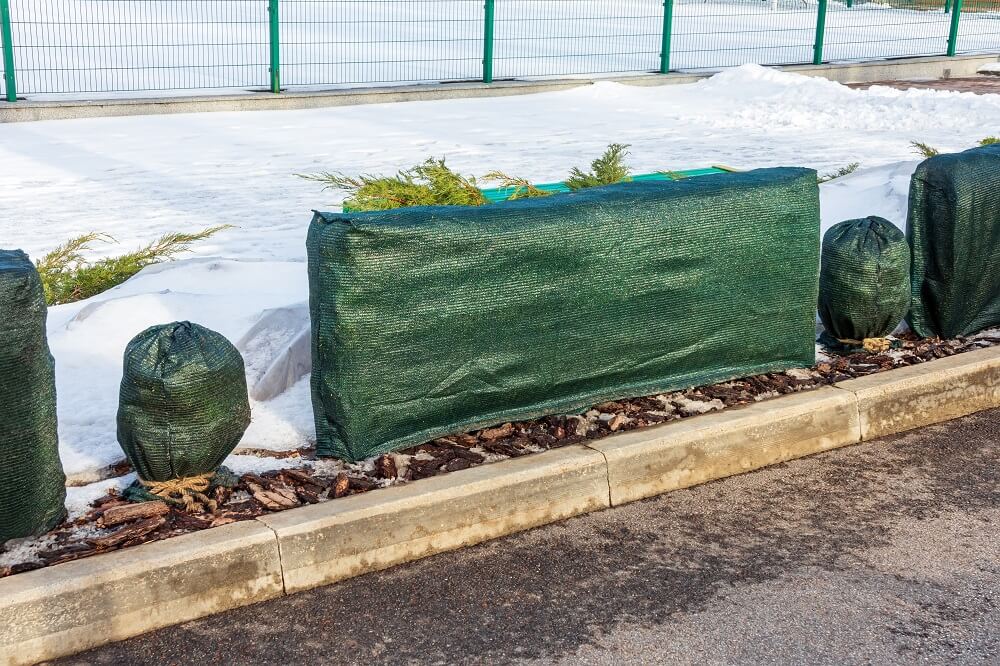
There are numerous benefits to using agro-textile fabric under thuyas, which contribute to the healthy growth of the plants and make maintenance easier. First and foremost, the agro-fleece effectively prevents the growth of weeds that can compete with the thuyas for water, nutrients and light. This gives the thuyas better conditions for growth and saves the garden owner the time and effort of weeding. Another advantage of agro-textile is its ability to retain moisture in the soil. The material reduces water evaporation, which is particularly important during periods of drought. As a result, the thuyas are less stressed and develop better. The agro-textile also helps to maintain a constant soil temperature, protecting the roots from extremes of temperature, both in the hot summer and the cold winter. In addition, the agro-textile influences the neatness and tidiness of the garden, improving its overall presentation.
Choosing the right agro-textile fabric under your thuyas is a key step in providing them with optimal growing conditions and protection from weeds. First of all, it is important to pay attention to the colour of the agro-textile — a black agro-textile is best for tues, which effectively blocks out light, preventing the growth of weeds, while allowing water and air to pass through to the soil. Another important aspect is the grammage, or density of the material. The right choice will ensure effective performance and durability. It is also worth paying attention to the quality of the material — a good quality agro-textile should be UV resistant, which ensures a longer service life. When buying a nonwoven agro-textile, it is also important to take into account its dimensions in order to fit it to the planned area of planting. A well-chosen nonwoven agro-textile makes it easier to care for the tuii, promoting their healthy growth and improving the aesthetics of the garden.
Deciding, what kind of thick fleece under thuyas will be the best, it is worth paying attention to the grammage of the material. For thuyas, the optimum weight of the agro-textile is between 50 and 100 g/m². An agro-textile fabric with a lower weight, e.g. 50–60 g/m², is lighter and more air- and water-permeable, which is good for young and delicate plants. However, its resistance to mechanical damage and weeds may be limited. On the other hand, an agro-woven fabric with a higher weight, such as 90–100 g/m², offers better protection against weeds and greater durability. The downside, however, is less air and water permeability, which can lead to problems with excessive moisture. Deciding, what kind of thick fleece under thuyas, it is therefore worth considering the needs of specific plants and environmental conditions to ensure that they have the opportunity to grow and, at the same time, the entire garden looks aesthetically pleasing.
Preparing the land before laying the agro-textile is a key step that affects the subsequent growth and health of our thuyas. The first step is to thoroughly remove weeds and other unwanted plants. This is best done by hand or with appropriate tools to avoid damaging the soil. The removal of weeds is important, as even the best agro-textile may not be able to cope with strong plants that can break through the material.
We then proceed to prepare the soil. It is important to level the ground and remove any stones, roots and other obstacles. The soil can also be gently loosened to allow better air and water circulation to the roots of the thuyas. Before laying the agro-textile fabric, it is also worth considering fertilising the soil with a suitable fertiliser adapted to the needs of the thuyas. In this way, you provide the plants with the right conditions for growth. When the ground is ready, you can start laying the fleece. Know this, how to lay agro-textile under thuyas, and a properly prepared area is the key to an aesthetically pleasing garden.
Above all, care must be taken not to damage the roots and shoots of the plants. It is best to start by removing the weeds around the thuyas to make laying the agro-textile easier later on. Then, using a knife or scissors, cut the shapes of the holes in the agro-textile adapted to the diameter of the shrubs.
When laying the agro-textile fabric, ensure that the material adheres well to the ground, minimising gaps through which weeds could enter. The material should overlap at the edges, preventing weed growth in the gaps. Special pins are used to attach the material. For extra aesthetics and protection, cover the agro-textile with a layer of bark or gravel. This will give the plants better conditions for growth and keep the garden looking neat. Knowing, how to lay agro-textile under thuyas, you will ensure their healthy development and the aesthetic appearance of your garden.
Keeping the agro-textile in good condition is crucial to its effectiveness and durability. Above all, its condition should be checked regularly, especially after strong winds or rainfall, which can displace or damage it. It is worth looking out for any tears and repairing them immediately to prevent weed infiltration. It is also important to attach the agro-textile to the ground properly. It is advisable to use special pins or pegs to ensure the stability of the material and prevent it from moving. Regular checking and refilling of these fixings is essential. In areas of heavy use, it is worth considering additional protection, for example by covering the agro-textile with bark or gravel, which will increase its durability and improve the appearance of the garden.